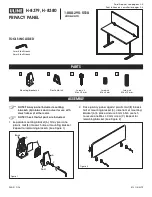
Page 8 of 61
OPERATOR’S MANUAL • Owandy-RX DC • 02/2020 • NXDCEN160A
Operator’s manual – Owandy-RX DC
PLEASE NOTE
This manual does not contain all the recommendations and the obligations relative to the possession of a source of ionising radiations – since
they do vary from Country to Country – but only the most common ones.
The user must consult his country’s legislation so as to fulfi l all local obligations.
!
WARNING
This manual describes how to set and use the
Owandy-RX DC
X-ray system.
The operator must read and understand the manual before using the medical device.
This manual must be always kept as a reference document.
Before using this device for the fi rst time, it is essential to thoroughly and carefully read the instructions, CAUTION and WARNING messages
listed in the present chapter.
It is mandatory to comply with these instructions every time the device is used.
Owandy-RX DC
is compatible with all kind of X-ray detectors which have been designed and certifi ed for dental intra-oral radiology; in detail,
such a compatibility is ensured by the compliance of the
Owandy-RX DC
device with the basic safety and essential performance requirements of
the IEC 60601-2-65: 2012.
1.3. QUALITY DETERMINANTS IN X-RAY INTRAORAL RADIOGRAPHY
Image quality is linked to the precise and accurate acquisition of information from the X-ray beam transmitted through
the patient (i.e., the X-ray detector). Most problems in dental radiography are not the result of X-ray
equipment failure: the production of consistent and high quality X-ray diagnostic images, concurrent with minimal patient
exposure, depends generally on different components:
quality performance of equipment, characteristics of the modules used which affect the imaging system resolution (i.e.:
X-ray image detector type and relevant image processing chain, analogue or digital) and optimal performance of the
operator.
Among the physical factors for achieving optimum image quality, the following can be considered:
- optimum optical density and Wiener spectrum,
- detectors for radiography must meet the needs of the specifi c radiological procedure where they will be used and key
parameters are spatial resolution, uniformity of response, contrast sensitivity, dynamic range, acquisition
speed and frame rate
- minimization of motion blurring (using short exposure times),
- minimization of geometric blurring (reducing the focal spot size and/or of the object-fi lm distance),
- geometric distortions,
- correct positioning: errors in patient positioning when using uncoupled positioning devices during the various typologies
of X-ray examinations may lead to exposure errors, which require additional X-ray exposures, thereby increasing the
radiation dose adsorbed by the patient.
This means that it is absolutely essential and mandatory that the operator consider the performances not only of the
Owandy-RX DC
equipment itself, but the whole chain of components that bring to the fi nal X-ray diagnostic image.
The essential parameters and relevant metrics which describe the performance of dental X-ray system, with regard to
imaging properties and patient dose, methods of testing and whether measured quantities related to those parameters
comply with the specifi ed tolerances, are stated by the respective manufacturers and by the requirements specifi ed by
the respective applicable standards.
Radiographic fi lms, fi lm processing, digital X-ray image detectors, and imaging plates are vital parts in the imaging
chain. It is responsibility of the operator to ensure that these components perform in an acceptable way, with respect
to sensitivity, contrast and absence of artifacts. A test of the performance of these components shall precede any
acceptance test measurement involving the irradiation of the X-ray detectors using the
Owandy-RX DC.









































